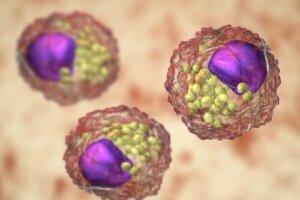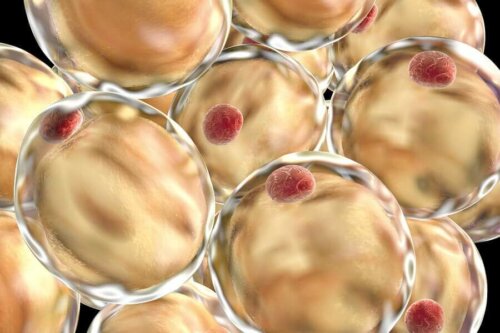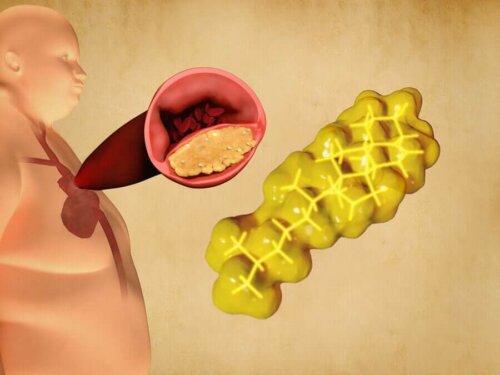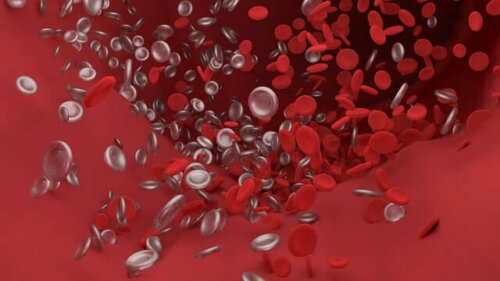Characteristics, Types, and Function of Lipids


Written and verified by the doctor Elisa Martin Cano
The function of lipids is important as it impacts our overall health. Not only are they key as an energy reserve for the body, but they also intervene in other essential processes such as the transport of nutrients and the regulation of body temperature, among others.
These substances are diverse and come from various sources. In fact, they’re known for the role they play when it comes to nurturing living beings. This is because they’re key for the assimilation of vitamins and for the optimal functioning of the metabolism.
So what exactly are lipids? What’s their function? You may have heard of them in the context of health and nutrition and might like to understand them better. We’ll tell you more about it below.
What’s the function of lipids
Lipids are a group of biological molecules that intervene in relevant body processes. Specifically, they’re part of the cell membrane and the basis for the production of hormones. Above all, they’re responsible for the storage of energy.
Furthermore, they’re composed of carbon and hydrogen and contain sulfur, nitrogen, and phosphorous to a lesser extent. In any case, their main characteristic is they’re water-insoluble and represent one of the main body energy reserves.
The term “lipid” is often used to refer to “fat” but not all lipids are fats. In turn, all fats are lipids. Thus, there are several types of lipids and these are classified according to their physical properties and functions.

Types of lipids
As detailed in an article published in the scientific Biochimica et Biophysica Acta journal, the term “lipids” groups together various compounds that have relevant biological functions. Therefore, it’s important to understand their classification when talking about these substances. What types of lipids are there?
Phospholipids
These are made up of chains of fatty acids, phosphate, and glycerol. They form hydrophobic structures, which means they repel water. Their most important function is the formation of cell membranes.
Furthermore, they also carry out other actions, such as the digestion of other fats in the small intestine. The body is capable of generating all the phospholipids it needs on its own.
Cholesterol
This is an essential body molecule. Contrary to what many people think, it isn’t always bad and it’s a part of the cell membranes. In addition, it’s the precursor of different substances, such as some vitamins and hormones such as steroids.
Thus, a certain amount of cholesterol is essential for the body to function properly. However, too much of it can lead to accumulation in the blood vessels. This could be a problem because there’s a greater risk of heart attacks or ischemic problems when the vessels become clogged.
Glycolipids
These fats also contain sugar molecules in their structure. Their most important function pertains to the immune system. They inhabit the outside of the cell membrane and function as a signal for it.
Triglycerides
These are made up of fat and alcohol. Specifically, they’re the molecules into which excess energy or sugars in the body transform. That is they produce their energy reserves.
As with cholesterol, an excess of triglycerides also tends to accumulate in the blood vessels and in the rest of the body. This is why high levels could lead to health problems.

Steroids
These are molecules made up of cholesterol and hormones. Some examples are testosterone and estrogen. Furthermore, they need cholesterol to be synthesized in the body. Specifically, they perform regulatory and activating functions.
It may interest you How Much Meat Should You Eat Per Week?
What’s the function of lipids in the body?
Depending on their type, lipids carry out many essential body functions. According to a publication in Molecular Biology of the Cell, these are structural or signaling functions. We’ll detail some of the most important ones below.
Energy reserve is the main function of lipids
The main function of this substance is as a body energy reserve. One gram of fat can provide 9 kilocalories to the body. When a person has an excess of sugars, these are stored in the form of fat deposits. They’ll be used when other sources of energy, such as carbohydrates, are lacking.
Structure formation
Some lipids form important structures in the body. Cell membranes are the most important example. They’re made up of a specific type of lipid; in turn, they’re essential for shaping and protecting the cell.
Cellular communication is a function of lipids
Cells communicate with each other through different substances that function as signals, such as vitamins, hormones, and glycolipids. Their function is to regulate various secretions and body responses.

Transport is another important function of lipids
There are lipids that function as transporters for other substances throughout the body, such as nutrients. In general, this function is performed in conjunction with bile acids and lipoproteins.
Thermal regulation
The fat deposits that accumulate under the skin and around the organs act as protectors from the cold. Fat traps heat and thus keeps the body warm.
Final notes about the function of lipids
The types and functions of lipids are varied and complex, although, in general, these organic compounds are essential for life. Also, to a certain extent, they’re decisive for the proper functioning of the body. However, some of them are harmful in excess.
As you can see, you must try to adopt and maintain healthy lifestyle habits, especially when it comes to food. Also, schedule regular medical check-ups. You must follow medical treatment if the levels are abnormal.
We hope you’ve enjoyed this article.
All cited sources were thoroughly reviewed by our team to ensure their quality, reliability, currency, and validity. The bibliography of this article was considered reliable and of academic or scientific accuracy.
- Ahmed S, Shah P, Ahmed O. Biochemistry, Lipids. [Updated 2020 May 19]. In: StatPearls [Internet]. Treasure Island (FL): StatPearls Publishing; 2020 Jan-. Available from: https://www.ncbi.nlm.nih.gov/books/NBK525952/
- National Research Council (US) Committee on Diet and Health. Diet and Health: Implications for Reducing Chronic Disease Risk. Washington (DC): National Academies Press (US); 1989. 7, Fats and Other Lipids. Available from: https://www.ncbi.nlm.nih.gov/books/NBK218759/
-
Huff T, Boyd B, Jialal I. Physiology, Cholesterol. [Updated 2020 Apr 15]. In: StatPearls [Internet]. Treasure Island (FL): StatPearls Publishing; 2020 Jan-. Available from: https://www.ncbi.nlm.nih.gov/books/NBK470561/
- Serrano Maddelainne H, Calle R, Valeria V. LIPIDOS: CARACTERISTICAS PRINCIPALES Y SU METABOLISMO.
-
Basdevant A. Steroids and lipid metabolism: mechanism of action. Int J Fertil. 1992;37 Suppl 2:93-97.
- Küllenberg D, Taylor LA, Schneider M, Massing U. Health effects of dietary phospholipids. Lipids Health Dis. 2012;11:3. Published 2012 Jan 5. doi:10.1186/1476-511X-11-3
- Muro E, Atilla-Gokcumen GE, Eggert US. Lipids in cell biology: how can we understand them better?. Mol Biol Cell. 2014;25(12):1819-1823. doi:10.1091/mbc.E13-09-0516
- Berg JM, Tymoczko JL, Stryer L. Biochemistry. 5th edition. New York: W H Freeman; 2002. Chapter 12, Lipids and Cell Membranes. Available from: https://www.ncbi.nlm.nih.gov/books/NBK21199/
- Sunshine H, Iruela-Arispe ML. Membrane lipids and cell signaling. Curr Opin Lipidol. 2017;28(5):408-413. doi:10.1097/MOL.0000000000000443
This text is provided for informational purposes only and does not replace consultation with a professional. If in doubt, consult your specialist.








